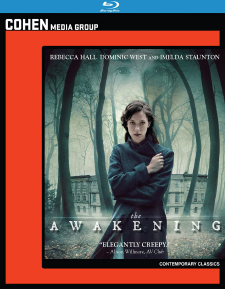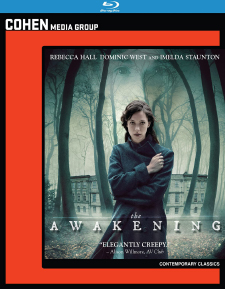Awakening, The (2011) (Blu-ray Review)

Director
Nick MurphyRelease Date(s)
2011 (October 5, 2021)Studio(s)
BBC Films/StudioCanal (Cohen Media Group)- Film/Program Grade: B-
- Video Grade: B+
- Audio Grade: A-
- Extras Grade: A-
Review
The Awakening is a somewhat overlooked 2011 horror film directed by British television veteran Nick Murphy. Despite the title, it bears no relationship to the 1980 archaeological horror film of the same name, but instead is a distant cousin to the Henry James novel The Turn of the Screw. The screenplay by Murphy and Stephen Volk takes place in post-WWI England, where Florence Cathcart (Rebecca Hall) is a paranormal investigator who specializes in debunking hoaxers who are taking advantage of grieving families of the wartime dead. Robert Mallory (Dominic West) asks her to delve into a boarding school for boys which has been plagued by ghostly apparitions, and she reluctantly agrees, only to find herself unexpectedly drawn into the events which are taking place.
On a superficial level, that may sound reminiscent of The Conjuring, but Florence Cathcart bears little resemblance to Lorraine or Ed Warren. She's more akin to Harry Houdini, as she's haunted by her own tragic personal loss from The Great War. She would love nothing more than to be able to contact her departed loved one, but her bitter disappointment in the fraud perpetrated by spiritualists drives her desire to expose them. She wants to believe, but she's lost faith in everything save for science, and the events of The Awakening will test her lack of faith.
Rebecca Hall simply can do no wrong, and her ability to express the interior mindset of her characters through subtle facial reactions makes her perfect to play this part. Florence’s hard-nosed skepticism is a mask to hide the bitterness and pain that she feels inside, and Hall is marvelous at showing the cracks through that facade. West is fine in the somewhat thankless role of her opposite number at the school, but it’s the great Imelda Staunton as the school’s housekeeper Maud who really proves the ideal foil for Hall—Staunton could play repressed characters like Maude in her sleep. Isaac Hempstead Wright is also noteworthy as one of the boys at the school who forms a connection to Florence.
Like many horror films of this sort, The Awakening suffers a bit from the fact that the questions are inevitably more interesting than the answers. There’s a major reveal during the finale which is more compelling in terms of how Florence relates to it than it is as the solution to a mystery. But that’s actually appropriate, since The Awakening is more of a character study than a horror film anyway. The scares aren’t particularly novel, but Murphy does a fine job of maintaining a sense of oppressive atmosphere which deteriorates in tandem with Florence’s mental state. The film ends on an ambiguous note, though it’s worth pointing out that there’s really only one interpretation for what has happened; the contradictory clues are deliberate red herrings. Viewers can still draw their own conclusions, but only one interpretation brings Florence’s character arc to its appropriate end.
Cinematographer Eduard Grau shot The Awakening in Super 35 mm using Panavision Panaflex Millennium XL2 and Panaflex Platinum cameras, with spherical Panavision Primo lenses. The film was finished as a 2K Digital Intermediate, framed at 2:35:1 for its theatrical release. The Awakening has a very distinctive visual look, but it’s one which makes assessing the quality of the transfer very difficult. For the majority of the film, the colors are so desaturated that they border on being monochromatic, and the contrast range is deliberately limited. It has the effect of creating a cold, faded, and flat look—Murphy wanted the world around the character to appear as if it was dying and in pain. There are only a few moments where color breaks out, either as an element within a scene, or in full for just two sequences in the film, both of which take place at night under artificial lighting. It’s the opposite of what most horror films would have done; in The Awakening, the sun offers no comfort. The heavy desaturation has the side effect of obscuring the fine detail throughout most of the film, and there’s also some noise from the DI grading mixed with the grain, which tends to smother even more detail. Facial textures do look sharp in extreme closeup, but otherwise they can be a bit murky. However, all of that appears to accurately replicate the look that Murphy wanted, so while it’s hardly a dazzling transfer, it is a faithful one.
Audio is offered in English 5.1 and 2.0 DTS-HD Master Audio, with optional English SDH subtitles. The 5.1 track is more precise and enveloping, and while it’s still focused toward the front channels, the surrounds are used effectively to provide atmosphere. Ambient sound effects can be everything to a horror film, and The Awakening provides enough of them to keep the viewer on edge—creaks, groans, echoes, and other eerie sound effects are always coming from unexpected directions. There’s also deep bass at a few key moments, including in the score by Daniel Pemberton. And while the visual may be foggy, the dialogue is perfectly clear.
Cohen Media Group’s Blu-ray release of The Awakening duplicates all of the extras from the previous Universal version, all of them in HD:
- Deleted Scenes Introduced by Nick Murphy (28:14)
- Anatomy of a Scene: Florence and the Lake (15:16)
- Extended Interview with Nick Murphy (19:29)
- Anatomy of a SCREAM (17:12)
- A Time for Ghosts (24:47)
- Behind the Scenes (36:02)
- Trailer (2:29)
The deleted scenes featurette has Murphy providing an overview of his thoughts about deleted scenes in general, before introducing each sequence and explaining why he cut them. The scenes include Florence in the Park, Car Journey, Meeting Rev. Purslow, The Doll’s House, Maud Distressed, Maud Cross with Tom, and The Lavish Room. (There’s no option to play them individually.) Anatomy of a Scene is a breakdown of a pivotal moment in the film, with Murphy explaining why it’s so important, and also showing the way it was shot. Both Hall and West give their own thoughts about the scene, and there are also interviews with several crew members who provide technical details, accompanied by behind-the-scenes footage. In the Extended Interview, Murphy talks about how horror isn’t a natural genre for him as a director, nor is it one of his favorites as a viewer. He feels that they tend to become exercises in and of themselves at the expense of the characters. After discussing his views of the characters in his film, he goes on to describe shooting the effects sequences, and also his methodology of doing the unexpected all throughout the film as a way of keeping audiences from anticipating surprises and to simply go with the flow.
Anatomy of a SCREAM features members of the cast and crew discussing their own beliefs regarding the supernatural, or lack thereof—Murphy makes it clear that he doesn’t believe in any of it (well, except perhaps for Father Christmas). It also includes Alan Murdie, the chairman of the Ghost Club, who shares his own feelings on the subject. A Time for Ghosts goes a step further from that by examining the broader context for The Awakening, delving into the rise of spiritualism in the post-WWI era in England. Murdie reappears here, along with Juliette Nicholson, author of The Great Silence. The Behind the Scenes featurette includes interviews with Hall, West, Staunton, Murphy, and producer David Thompson, as well as some behind-the-scenes footage. They discuss the story, the characters, the costumes, and the visual design of the film. Murphy explains why the colors are so desaturated, and says that the guideline he gave to the crew was to replicate the look of an old, worn pewter pot. Hall talks about how the film appealed to her because it tried to avoid Gothic tropes and let much of the horror be revealed in full daylight.
Cohen Media Group’s Blu-ray for The Awakening is essentially identical to Universal’s, so there’s no reason to upgrade for owners of that disc. But for those who don’t already have it, this is a nice release with a pretty comprehensive collection of extras.
- Stephen Bjork
(You can follow Stephen on Facebook at this link)

